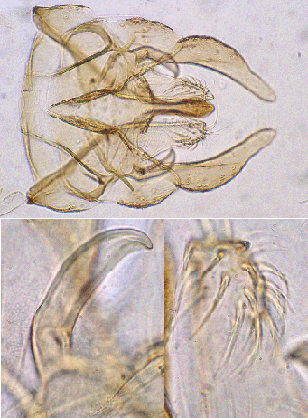C. tyleri holotype
The adults are very similar to those of members of the C. oppositus group and accurate identification is currently only possible from the sequences of the polytene chromosomes. Despite this, conventional types are designated in the hope that distinguishing characters may be found in the future. The types are specimens reared from cytologically identified egg masses to ensure accurate identification.
Colour: Head, antennae and mouth parts brown.Thorax generally greenish with brown stripes; thorax pruinose, postnotum and sternopleuron yellowish brown.
Wings with anterior veins hardly darker than posterior, crossvein slightly darkened.
Legs ???
Abdomen generally greenish with narrow to broader saddle markings on the anterior segments, gradually extending in length from about tergum 5 to occupy most of the tergum by segment 8.
Wing length 4.39 mm; width 0.94 mm; VR 0.96; 3 SCf on brachiolum; about 31 setae in squamal fringe.
AR: 3.08; antennal pedicel about 220 µm in diameter.; Frontal tubercles 40 µm long and 14 µm wide. : :About 28 orbital setae.
Palpal proportions (micron): 63 : 75 : 225 : 245 : 400.
Clypeus about 1.9 times the diameter of the antennal pedicel; 24 Clypeal setae.
Thoracic setae: Acrostichal - 18; Dorsolateral - 18 (beginning about the suture); Prealars - 5, 6; Supraalar 1; Scutellars not visible (scutellum damaged).
Leg lengths (micron) and proportions:
|
Fe
|
Ti
|
Ta1
|
Ta2
|
Ta3
|
Ta4
|
Ta5
|
LR
|
F/T
|
BR
|
PI
|
1520
|
1355
|
2125
|
1105
|
885
|
765
|
350
|
1.57
|
1.12
|
2.22
|
PII
|
1680
|
1555
|
920
|
500
|
365
|
240
|
180
|
0.59
|
1.08
|
|
PIII
|
1900
|
2000
|
1365
|
740
|
575
|
365
|
220
|
0.68
|
0.95
|
|
18 setae in a single pale patch on tergite IX. Superior volsella of D(e)-type of Strenzke (1959); inferior volsella reaching to about 2/3 along length of the anal point, which is narrower near base. Recurved setae at tip of inferior volsella simple.

Type locality: Tasmania - Bellerive (42.87°S, 147.37°E).
[ Return to Index | Go to C. tyleri adults
| 